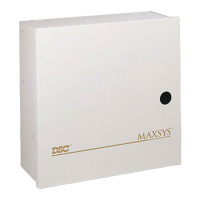8
The control panel monitors the presence of AC. Upon the
loss of AC power a trouble condition will be generated.
The keypad trouble light will turn on. If programmed, the
keypad will also beep. For more information regarding AC
options, see 10.1 ‘AC/DC Power Options‘.
Applying Power to the Main Panel
Once all field wiring has been completed and checked for
opens, shorts and grounds, power can be applied to the
panel as follows:
1. Connect the battery leads.
2. Connect the AC transformer.
The panel will not power up correctly if AC power is
applied before the battery is connected.
Battery Selection Charts
The charts below are to determine the battery required to
support the main panel for either 24 hours or 60 hours in
the standby mode. The battery size is measured in amp
hours (Ah). To determine the appropriate battery size, per-
form the following:
1. Calculate the total current required when the panel is
not in alarm. This is the standby current. See section
2.4 for further information on current calculation.
2. Determine the current that will be drawn when the
panel is in alarm.
3. On the chart below, find the standby current on the hor-
izontal axis and the alarm current on the vertical axis.
4. Find the region of the chart where the standby current
and the alarm current values intersect. The region cor-
responds to the required battery Ah capacity.
For example:
Standby current = 500 mA
Alarm current = 2 A
On the 24Hr chart, the battery capacity required is 14Ah.
2.15 Lithium Batteries
The PC4020 circuit board includes a lithium battery
(please see the wiring diagram on page ii.) This battery is
not replaceable. There is a danger of explosion if the bat-
tery is incorrectly replaced.
If the lithium battery stops working, return the circuit
board to your distributor. Batteries may cause a fire when
in contact with metal. If you need to dispose of the circuit
board and/or the lithium battery, wrap the battery in non-
conductive tape. Check with your local government for
battery disposal regulations.
WARNING: Do not store the batteries in such a way
that they come into contact with each other or with any
piece of metal. Explosion or fire may occur. Should fire
occur, use only dry chemical fire extinguishers. Do not
use water to put out the fire.
Do not heat the batteries. Do not dispose of the batter-
ies or circuit boards in a fire. Do not disassemble the
batteries. Do not apply pressure to or deform the bat-
teries. Ensure that the above precautions are strictly
observed by related departments, including, but not
limited to, production, sales and outside contractors.

